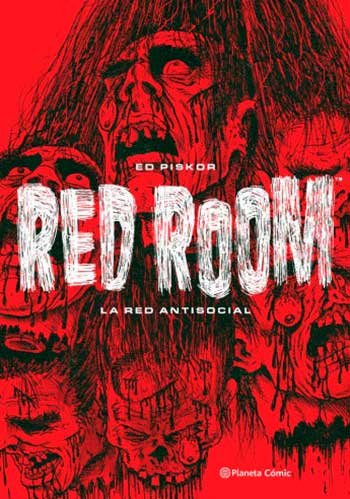“Red Room. La red antisocial” by Ed Piskor is a comic that is capable of arousing considerable concern in any sane reader, even if they are a regular reader of underground and avant-garde material. The author of this review was, during the nineties, a teenager who did not miss the long-awaited spaces dedicated on the small screen to the horror movies “Alucine” and “Noche de lobos” every weekend; there, together with jewels of European fanterror or the wonderful Hammer films of the sixties and seventies, they could program you an indiscriminate gore bloodbath like “Cannibal holocaust” o “The Hills Have Eyes”. But now, having become a moderately functional adult, perhaps he would have preferred not to venture into the troubled pages of “Red Room”. That doesn’t stop him from being aware that his 1997 or 1998 version would have enjoyed it. So you are sure that this comic will find an audience that will appreciate it.
As he happily confesses to us in the prologue, the four numbers contained in this volume are part of a larger project, of the configuration of a universe. In that sense, they work perfectly: they tell us several independent stories, but they help to show us different aspects of a world that, perhaps, we would have preferred not to know. “Red Room” takes its title from an urban legend, according to which on the Dark Web you can find pages that offer scenes of real torture and murder online, something that, on the other hand, also inspired a disturbing and misunderstood film by the great Olivier two decades ago Assayas, “Demonlover”. Thus, in the “red rooms”, with a faithful public in front of the screens, the most grotesque and terrifying scenes imaginable take place. Little by little, we discover where the victims come from, who are the “producers” of this material and who are the executioners, those individuals who find their “vocation” in such a peculiar activity. Of course, everything is scary.
Above all, we follow in the footsteps of one of those last characters, Davis Fairfield, who is apparently an honest civil servant, a good father and husband, but who, inside, hides a ferocious serial killer. Fairfield is recruited to be part of the show and becomes the “Decimator”, a superstar of the show. It is not difficult to detect several plausibility problems in what Piskor proposes; It’s quite complicated for such an organized and hierarchical underground industry to exist under our eyes, but it’s clear that he doesn’t care: what he wants is to shock and horrify, and he spares no visual resources to achieve it.
As a reader, it would be easier to ignore the savage cruelty of this work, if it had not been done by a talented cartoonist; but the fact is that Piskor has it, and a lot of it. Former collaborator of indie comics legend Harvey Pekar, the author of “American Splendor”earned his own place in the ninth art scene, thanks to two monumental works: “Hip Hop Family Tree”, a tale of the origins of American rap culture and the pioneers who shaped it; and “X-Men: Grand Design”, in which he dared to retell the saga of Marvel’s mutants. After touring his “Red Room”, It is confirmed that he is a good scriptwriter and an excellent cartoonist, but the author of this review would prefer not to have any contact with him again.
